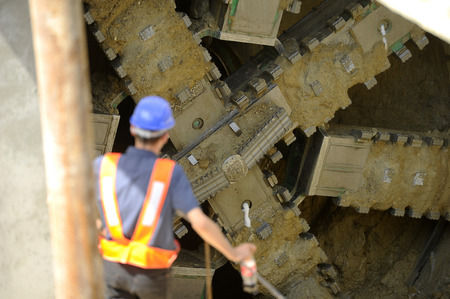SECTION 26 - UNDERGROUND CONSTRUCTION (TUNNELS), SHAFTS AND CAISSONS
26. General.
This section applies to the construction of underground tunnels, shafts, chambers, and passageways.
This section also applies to cut-and-cover excavations which are both physically connected to ongoing underground construction operations within the scope of this section, and covered in such a manner as to create conditions characteristic of underground construction.
26.A.01 Access and Egress.
- Access to all underground openings must be controlled to prevent unauthorized entry.
- Unused access ways or other openings must be tightly covered or fenced off and must be posted with warning signs indicating "KEEP OUT" or similar language.
- Completed or unused sections of underground structures must be barricaded.
- See Section 34 of this manual for confined space requirements.
26.A.02 Every location of underground construction must have a check-in/check-out system that will ensure that above-ground personnel can determine the identification of all underground personnel.
26.A.03 Oncoming shifts must be informed of any hazardous occurrences or conditions that have affected or might affect employee safety, including liberation of gas, equipment failures, earth or rock slides, cave-ins, flooding, fires, or explosions.
26.A.04 Communications.
- In situations where unassisted voice communication is inadequate, power-assisted means must be used to provide communication among workers and support personnel.
- At least two effective means of communication (at least one of which must be voice communication) must be provided in all shafts that are being developed or used either for personnel access or for hoisting.
- Powered communication systems must operate on an independent power supply and must be installed so that the use of or disruption of any one phone or signal location will not disrupt the operation of the system from any other location.
- Communication systems must be tested upon initial entry of each shift to the underground and as often as necessary thereafter to ensure proper operation.
- Any employee working alone underground, who is both out of range of natural unassisted voice communication and not under observation by other persons, must be provided with effective means to communicate the need for and to obtain emergency assistance. Employees working alone must be required to check in with their supervisor at least once an hour.
Knowledge Check Choose the best answer for the question.
26-1. Which means of communication must be used in all shafts that are being developed or used either for personnel access or for hoisting?
You forgot to answer the question!

